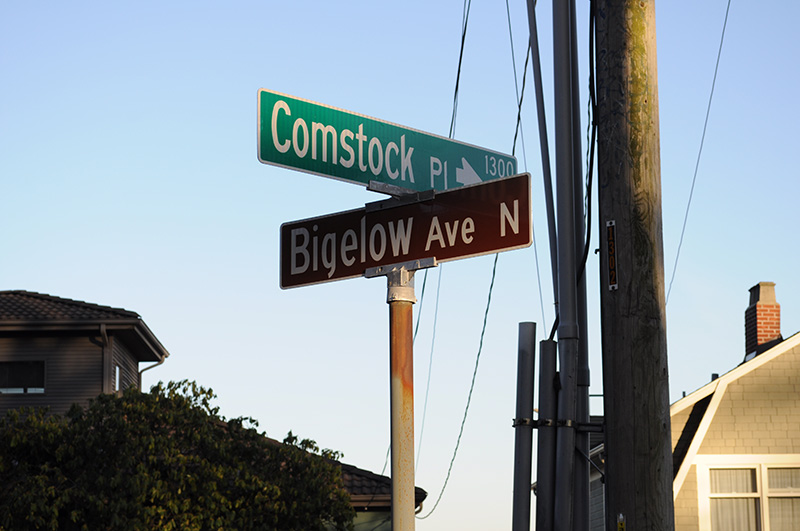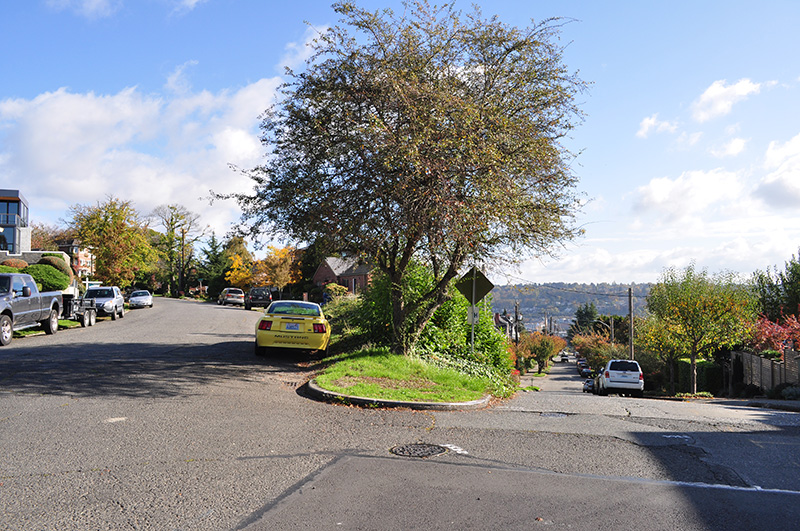This street was named for developer Isaac Newton Bigelow (1838–1922). The Queen Anne Historic Context Statement, as we quoted in Newton Street, says:
In the early 1870s, the Denny and Mercer families gradually began to systematically subdivide their large land holdings on the south and east slopes of Queen Anne Hill. When a severe windstorm blew down thousands of trees in the north district in 1875, views opened up and land seekers turned their attentions beyond Belltown. Real estate speculators new to the territory arrived and began to buy up property on the crest of Queen Anne Hill. Some of these speculators also became developers, such as George Kinnear, or builder-developers, such as Isaac Bigelow.
Bigelow Avenue N forms a major part of Queen Anne Boulevard, the scenic loop atop Queen Anne Hill. It begins at 2nd Avenue N and Prospect Street and goes 9⁄10 of a mile to Wheeler Street between 4th Avenue N and 5th Avenue N.
Part of the street is lined with chestnut trees — not horse chestnuts, but the edible variety, specifically the Chinese chestnut, Castanea mollissima, according to the city’s records. My family (my mother was Korean) never foraged here, though we have done so elsewhere in the area, both for chestnuts and fiddlehead ferns. But plenty of others have, and continue to do so, as these articles show:
- Nut-picking has neighbors fuming — Complaints sour scramble for sweet treats, The Seattle Times, October 9, 1992
- Every year, the street goes nuts, The Seattle Times, October 4, 2006
- Chestnut wars: Squirrels vs. old Asian ladies, The Black Plate Special, October 29, 2014
It should be noted that since Bigelow Avenue N is part of Queen Anne Boulevard, the trees belong to the parks department, not to the neighbors. As with similar park boulevards in town, neighbors’ yards often encroach on the public right-of-way.


Born and raised in Seattle, Benjamin Donguk Lukoff had his interest in local history kindled at the age of six, when his father bought him settler granddaughter Sophie Frye Bass’s Pig-Tail Days in Old Seattle at the gift shop of the Museum of History and Industry. He studied English, Russian, and linguistics at the University of Washington, and went on to earn his master’s in English linguistics from University College London. His book of rephotography, Seattle Then and Now, was published in 2010. An updated version came out in 2015.
Love the accuracy of your stuff! Do you have any information on the naming of Howe Street? Eastlake neighbors are soon to celebrate the extension of the Howe Street Stairs. I’m working on some history. Eastlake’s Howe Street was Bloomfield Street from Hilton’s Addition in July 1889 until the great re-naming of 1895. My gut tells me Howe Street is named for James Blake Howe (1861-1930), an aristocratic southern lawyer who arrived in Seattle June 6, 1889. His home at 22 West Highland Drive is one of the finest mansions remaining on Queen Anne. Land plats and real estate transactions would have been a dominating portion of a young corporate lawyer’s business during Howe’s first 6 years in Seattle – between the Great Fire and the great re-naming. James B. Howe was not a self-promoter. He would have strongly protested to anyone trying to name a street after him. But sneaking in a Howe Street in his honor is my guess. Do you know the origins of Howe in Howe Street?
Thank you! I haven’t tackled Howe Street yet, but your theory seems reasonable on its face. I will see if there is anything I can dig up. I hadn’t heard about the extension project. Is this it?
The Howe Street Steps project is an Eastlake neighborhood project to extend the stairs to Fairview Avenue. Its official opening is sometime in May. I’ve been charged with digging up some history. There is much speculation, but very little verifiable fact about anything involved — year built, purpose for and named for. James Blake Howe is not a sympathetic character in Seattle’s history — the local agent of Stevens & Webster, the behind-the-scenes lawyer-villain opposed to the public ownership schemes of Cotterill, Ross and Thompson. I have two guesses about Howe Street. First, some small plat submitted between 1889 and 1895 in Magnolia or West Queen Anne so honored J.B. Howe. Or second: drafters of the great re-naming ordinance of 4044 added Howe’s name. He almost certainly was a significant unpaid resource in that ordinance. Proving either guess is likely going to come from a random find somewhere.
It looks as if your second guess is correct. Howe got its name as part of the Great Renaming (linking to the Internet Archive version instead of the city’s website because it’s been down for a while (why they can’t put a little more money into their system I do not understand).